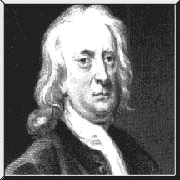 Isaac
Newton
was born in England at Woolsthorpe, near Grantham in
Lincolnshire, on January 4, 1643. His mother, who was widowed twice
in Isaac’s childhood, sent him to grammar school in Grantham. In
1661, he went to Trinity College of Cambridge University, receiving
his bachelor’s degree in 1665. Newton then left school two years
to escape the plague, returning to Trinity College on fellowship and
receiving a master’s degree in 1668.
Isaac
Newton
was born in England at Woolsthorpe, near Grantham in
Lincolnshire, on January 4, 1643. His mother, who was widowed twice
in Isaac’s childhood, sent him to grammar school in Grantham. In
1661, he went to Trinity College of Cambridge University, receiving
his bachelor’s degree in 1665. Newton then left school two years
to escape the plague, returning to Trinity College on fellowship and
receiving a master’s degree in 1668.
First among his achievements were those in mathematics. Newton studied methods of drawing tangents to curves and calculating the area beneath them. These were combined in what he called the fluxional method. By late 1666 he had developed a form of mathematics now known as calculus. This was the first major step beyond classical Greek geometry. In 1969 Newton was appointed Lucasian Professor of Mathematics at Cambridge.
In optics, he realized that sunlight consisted of a blend of different colors. This was demonstrated by shining light through a prism, refracting the light into separate colors. In 1672, Newton submitted an exposition of his theory of colors to the Royal Society’s Philosophical Transactions, which drew wide criticism. A major text, Optiks, was published in 1704.
Motivated by a discussion with Edmund Halley, in 1684 he returned to studies of gravitation and motion. These led to his three laws of motion and theory of universal gravitation, later published in 1687 as the Principia Mathematica.
In addition to his accomplishments in mathematics and science, Newton helped lead efforts to resist efforts by King James II to catholicize Cambridge. In 1693, he began to show symptoms of severe emotional disorder. He was appointed warden, then master, of the Royal Mint in London in 1696. In 1703 he was elected president of the Royal Society, which he remained until his death in 1727.
Page created by: Rika Watabe
Reference
Christianson, Gale E. (1984).In the Presence of the Creator. New York: The Free Press.